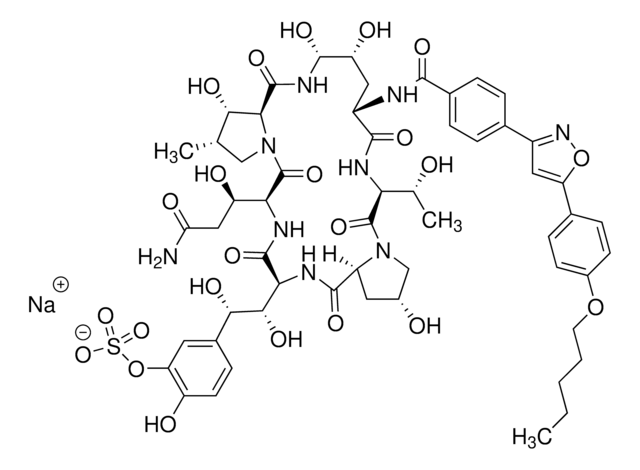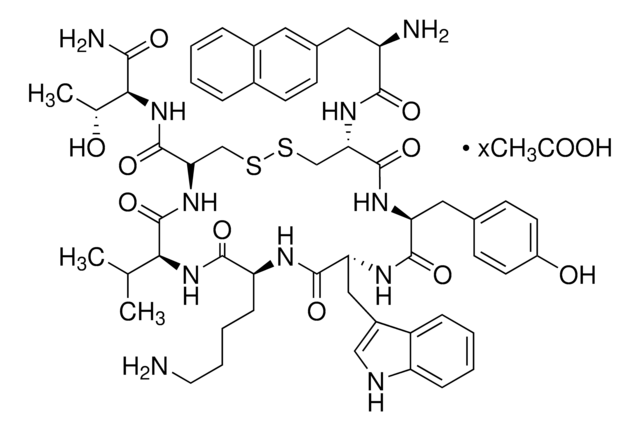SML0425
Caspofungin diacetate
≥97% (HPLC), powder, antifungal drug
Synonym(s):
1-[(4R,5S)-5-[(2-Aminoethyl)amino]-N2-(10,12-dimethyl-1-oxotetradecyl)-4-hydroxy-L-ornithine]-5-[(3R)-3-hydroxy-L-ornithine]-pneumocandin B0
About This Item
Recommended Products
Product Name
Caspofungin diacetate, ≥97% (HPLC)
Quality Level
Assay
≥97% (HPLC)
form
powder
color
white to beige
solubility
H2O: 15 mg/mL (clear solution)
shipped in
wet ice
storage temp.
−20°C
SMILES string
CC([O-])=O.CC([O-])=O.CC[C@H](C)C[C@H](C)CCCCCCCCC(=O)N[C@H]1C[C@@H](O)[C@@H](NCC[NH3+])NC(=O)[C@@H]2[C@@H](O)CCN2C(=O)[C@@H](NC(=O)[C@@H](NC(=O)[C@@H]3C[C@@H](O)CN3C(=O)[C@@H](NC1=O)[C@@H](C)O)[C@H](O)[C@@H](O)c4ccc(O)cc4)[C@H](O)CC[NH3+]
InChI
1S/C52H88N10O15.2C2H4O2/c1-5-28(2)24-29(3)12-10-8-6-7-9-11-13-39(69)56-34-26-38(68)46(55-22-21-54)60-50(75)43-37(67)19-23-61(43)52(77)41(36(66)18-20-53)58-49(74)42(45(71)44(70)31-14-16-32(64)17-15-31)59-48(73)35-25-33(65)27-62(35)51(76)40(30(4)63)57-47(34)72;2*1-2(3)4/h14-17,28-30,33-38,40-46,55,63-68,70-71H,5-13,18-27,53-54H2,1-4H3,(H,56,69)(H,57,72)(H,58,74)(H,59,73)(H,60,75);2*1H3,(H,3,4)/t28-,29+,30+,33+,34-,35-,36+,37-,38+,40-,41-,42-,43-,44-,45-,46-;;/m0../s1
InChI key
OGUJBRYAAJYXQP-IJFZAWIJSA-N
Looking for similar products? Visit Product Comparison Guide
General description
Application
- in an antifungal susceptibility test
- as a standard antifungal for valproic acid (VPA)-synergy assessment
- to treat Cryptococcus neoformans strain B3501 to study natural killer (NK) cell killing of Cryptococcus in the presence of β-1,3-glucan
Biochem/physiol Actions
Storage Class Code
11 - Combustible Solids
WGK
WGK 3
Flash Point(F)
Not applicable
Flash Point(C)
Not applicable
Choose from one of the most recent versions:
Already Own This Product?
Find documentation for the products that you have recently purchased in the Document Library.
Customers Also Viewed
Our team of scientists has experience in all areas of research including Life Science, Material Science, Chemical Synthesis, Chromatography, Analytical and many others.
Contact Technical Service












